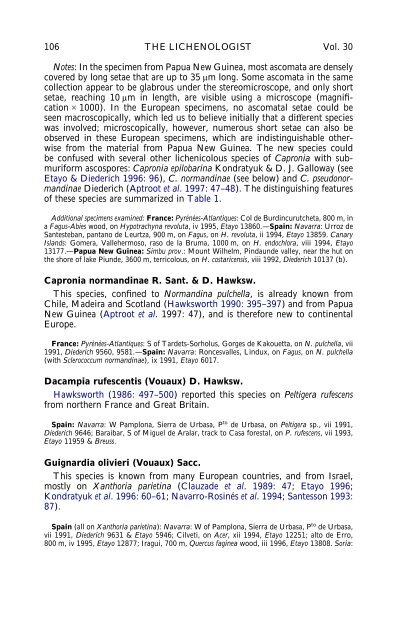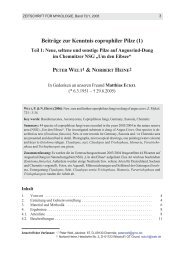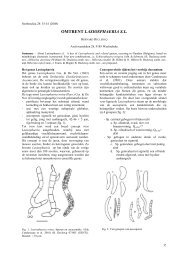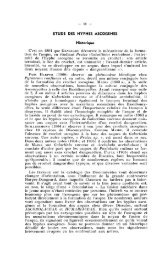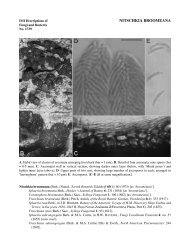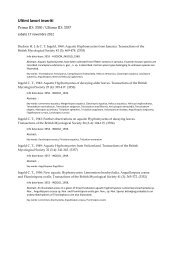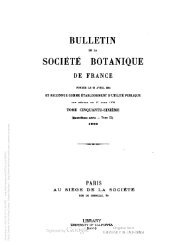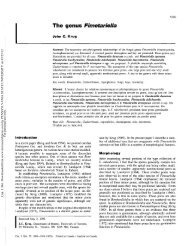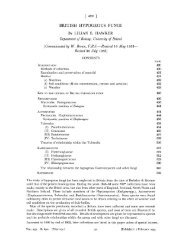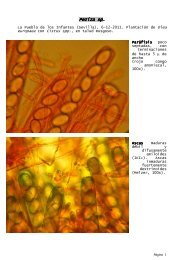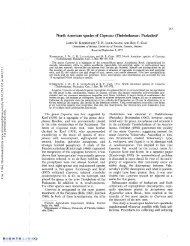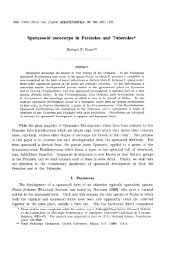LICHENICOLOUS FUNGI FROM THE WESTERN PYRENEES, FRANCE AND SPAIN ...
LICHENICOLOUS FUNGI FROM THE WESTERN PYRENEES, FRANCE AND SPAIN ...
LICHENICOLOUS FUNGI FROM THE WESTERN PYRENEES, FRANCE AND SPAIN ...
Create successful ePaper yourself
Turn your PDF publications into a flip-book with our unique Google optimized e-Paper software.
106 <strong>THE</strong> LICHENOLOGIST Vol. 30<br />
Notes: In the specimen from Papua New Guinea, most ascomata are densely<br />
covered by long setae that are up to 35 m long. Some ascomata in the same<br />
collection appear to be glabrous under the stereomicroscope, and only short<br />
setae, reaching 10 m in length, are visible using a microscope (magnification1000).<br />
In the European specimens, no ascomatal setae could be<br />
seen macroscopically, which led us to believe initially that a different species<br />
was involved; microscopically, however, numerous short setae can also be<br />
observed in these European specimens, which are indistinguishable otherwise<br />
from the material from Papua New Guinea. The new species could<br />
be confused with several other lichenicolous species of Capronia with submuriform<br />
ascospores: Capronia epilobarina Kondratyuk & D. J. Galloway (see<br />
Etayo & Diederich 1996: 96), C. normandinae (see below) and C. pseudonormandinae<br />
Diederich (Aptroot et al. 1997: 47–48). The distinguishing features<br />
of these species are summarized in Table 1.<br />
Additional specimens examined: France: Pyrénées-Atlantiques: Col de Burdincurutcheta, 800 m, in<br />
a Fagus-Abies wood, on Hypotrachyna revoluta, iv 1995, Etayo 13860.—Spain: Navarra: Urroz de<br />
Santesteban, pantano de Leurtza, 900 m, on Fagus, onH. revoluta, ii 1994, Etayo 13859. Canary<br />
Islands: Gomera, Vallehermoso, raso de la Bruma, 1000 m, on H. endochlora, viii 1994, Etayo<br />
13177.—Papua New Guinea: Simbu prov.: Mount Wilhelm, Pindaunde valley, near the hut on<br />
the shore of lake Piunde, 3600 m, terricolous, on H. costaricensis, viii 1992, Diederich 10137 (b).<br />
Capronia normandinae R. Sant. & D. Hawksw.<br />
This species, confined to Normandina pulchella, is already known from<br />
Chile, Madeira and Scotland (Hawksworth 1990: 395–397) and from Papua<br />
New Guinea (Aptroot et al. 1997: 47), and is therefore new to continental<br />
Europe.<br />
France: Pyrénées-Atlantiques: S of Tardets-Sorholus, Gorges de Kakouetta, on N. pulchella, vii<br />
1991, Diederich 9560, 9581.—Spain: Navarra: Roncesvalles, Lindux, on Fagus, onN. pulchella<br />
(with Sclerococcum normandinae), ix 1991, Etayo 6017.<br />
Dacampia rufescentis (Vouaux) D. Hawksw.<br />
Hawksworth (1986: 497–500) reported this species on Peltigera rufescens<br />
from northern France and Great Britain.<br />
Spain: Navarra: W Pamplona, Sierra de Urbasa, P to de Urbasa, on Peltigera sp., vii 1991,<br />
Diederich 9646; Baraibar, S of Miguel de Aralar, track to Casa forestal, on P. rufescens, vii 1993,<br />
Etayo 11959 & Breuss.<br />
Guignardia olivieri (Vouaux) Sacc.<br />
This species is known from many European countries, and from Israel,<br />
mostly on Xanthoria parietina (Clauzade et al. 1989: 47; Etayo 1996;<br />
Kondratyuk et al. 1996: 60–61; Navarro-Rosinés et al. 1994; Santesson 1993:<br />
87).<br />
Spain (all on Xanthoria parietina): Navarra: W of Pamplona, Sierra de Urbasa, P to de Urbasa,<br />
vii 1991, Diederich 9631 & Etayo 5946; Cilveti, on Acer, xii 1994, Etayo 12251; alto de Erro,<br />
800 m, iv 1995, Etayo 12877; Iragui, 700 m, Quercus faginea wood, iii 1996, Etayo 13808. Soria:


